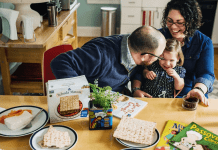My husband and I have walked into my late mother-in-law’s house for the last time.
We are in the process of settling her estate, including the sale of her house and disposition of everything in it.
From a hutch filled with china and crystal goblets to overflowing jewelry boxes and coin collections. And everything in between.
A lot in between.
Her clothes. The Notre Dame sweaters my late father-in-law was so fond of wearing. Her furniture. Furniture inherited from her mother-in-law, still in the same place in the garage where it was originally placed 30 some-odd years ago. My husband’s Cub Scout uniform. Christmas decorations. Lots and lots of Christmas decorations.
Every room, every closet, every shelf, every drawer. Full of stuff. A lifetime of stuff. Two lifetimes, if you count my father-in-law, who passed away 11 years ago.
What to Do With a Lifetime of Stuff
My mother-in-law was a neat and tidy housekeeper. But like many of us (myself included), she lived in a good-sized house with plenty of room to accommodate stuff. Things inherited from her parents and her in-laws. The broken vacuum cleaner waiting for repair in the back of the closet. Hundreds of books read once. You get the picture.
And the cost of disposing of all of that stuff? Having the estate sale company we hired go through every room, every closet, every drawer, separating the trash from the treasures, may cost more than will be generated at the eventual estate sale.
Her house has been transformed into a store, the estate sale company having cleverly arranged and displayed my mother-in-law’s possessions on tables in every room.
All of her possessions with any value, save the very few we kept, each with a tiny white price tag.
Losing your last surviving parent is hard enough. But being the arbiter of which of your parents’ and grandparents’ treasures get saved and which end up sold, donated, or in a landfill? gut-wrenching.
The lesson we have learned from this experience?
Most of the stuff in your house is worthless. And eventually, someone, either you or your kids, will be tasked with the overwhelming job of getting rid of it.
Most of Your Stuff Is Worthless
Most of the stuff in your house is worthless.
Yes, even the stuff you worry the most about, the stuff you think is so good you don’t use it for fear of breaking it, has little to no resale value.
From china, china cabinets, crystal goblets, silver tea sets, pianos, and collectible figurines like Hummels, to grandfather clocks and real pieces of craftsmanship furniture.
Why? Baby boomers have glutted the market with their castoffs, and millennials, the next generation of buyers, don’t want it.
Millennials hate both formal in-home entertaining and use of second-hand goods. With looming student loans, they tend to rent and move often. Who wants to be constantly moving a piano and a grandfather clock from apartment to apartment?
And furniture? There’s no market for so-called “brown furniture,” meaning any furniture (regardless of quality) other than the “mid-century casual” furniture (think clean, lightweight) favored by millennials. Brown furniture is basically firewood.
If it’s not in great condition, it’s also not fit for donation because it can’t be resold.
All of my mother-in-law’s furniture (including the pieces inherited from her mother-in-law and kept for decades)? Straight to the landfill.
Well, Almost Everything…
What do guns, LPs (records), and precious metals/gems have in common?
They are 3 things you might have in your house with a robust resale value.
Silverware also has value, but only if it is real silver and can be melted down.
3 Things You Should Be Doing NOW to Reduce the Amount of Stuff You Have
1. Be viciously thoughtful about holding onto sentimental items.
Here was our goal with sorting through my mother-in-law’s things. Keep just enough to remind us of her, but not so much stuff that our daughters are going to be dealing with it 40 some-odd years from now.
Here’s what we kept:
- A painting to be displayed in our dining room
- My mother-in-law’s treasured Swarovski crystal animal collection (all of which were given to her by her children and grandchildren over the years)
- Jewelry to be divided among the granddaughters
- Each of our daughters got to select 1 item
And that was it.
Well, almost. We did set aside photos to be digitized (with the originals then destroyed).
Was it hard leaving everything else? You bet it was. But we don’t want to be dealing with a lot of stuff years from now (or worse, leaving it to our daughters to deal with).
I try to be viciously thoughtful with my own sentimental items. For example, I don’t save any school papers or art projects from my kids (though I do take photos of my favorites).
2. Buy fewer books.
While used book resellers like Half Price Books do an important service in keeping books in circulation, a surprising number of books end up in landfills because many paper recycling facilities can’t process the the glue that binds book spines.
My resolution last year was to cut down on my book consumption by only reading books that I borrow from the library or purchase on my Kindle e-reader. If you haven’t used a library in years, now is the time to go back. My local library has an app where you can “order” books online, and pick them up the next day on a special “hold” shelf strategically placed next to the check-out kiosk.
How successful was I on my resolution? I read 1 to 2 books a week in 2019, only 1 of which was a hard copy purchased from Amazon.
3. Buy fewer, but better quality, clothes
The world is overflowing with used clothing.
We buy substantially more clothing over our lifetimes than our grandparents did.
Clothing made today is meant to last no more than a few years. In fact, a lot of clothing isn’t even made to withstand more than a few washes.
Think you are “paying it forward” but dropping off a load of unwanted clothes at Goodwill? Think again. Most clothing donations never make it to the racks at Goodwill and only about a third of what does eventually sells.
To really pay it forward, cut down on the amount of clothing you have by buying better quality clothes that last longer.
Keeping What Really Matters
My 5-year-old chose to keep a Christmas music box from her Grandma’s house. It plays “White Christmas” and has tiny ice skaters going around a rink inside. Each Christmas, my mother-in-law would bring out this music box and let each of her granddaughter’s play with it. It’s value in preserving a precious memory of Grandma? Priceless.














Collectibles will have their day again as inflation picks up down the road and millennials age and decide they want nice things rather than disposable…. fad!
ALL–I mean EVERY word of what you said is TRUE–PAINFULLY TRUE!!! There were six of us siblings to “divide” up–what we actually left with we could have carried out of the house–well, except for me–I couldn’t stand to leave her “treasures” behind. NOW I have those treasures still in my garage ALONG with a TON of my stuff after clearing out my house after my husband passed away a year and a half ago. ALL that STUFF screams at me every time I get in my car-parked strategically because there’s barely enough room in there because of all the STUFF. Oh, yes, our storage that I pay A LOT for EVERY MONTH–Exactly–MORE STUFF–been there for 29 1/2 years–paying storage on!!!! BUT, I think reading your article might just be the SPARK to make CLEARING out a possibility–NO a MUST for this year. THANK YOU!!!!! Harriett
Both of my parents died this last summer. Us four sibs went through everything, not because it was worth anything, but because it was valuable in sentiment. If it’s not worth your precious time to take a week or two to go through all they lovingly collected, maybe they gave you too much when you grew up.
Hog wash we each have to deal with stuff, ours,other loved ones, and all in our own way and unless u want to come and help me, don’t try to tell me how to do it. I’d like to move faster but at 80 it “ain’t”easy. It takes more than one look and it takes loving help if u don’t do it alone.
I like your comment, Gertrude.
I recently turned 70yo and my new motto is “if I don’t need it or love it, off it goes”. This has helped me tremendously. I have all that 1940’s china/crystal/linens, plus “keepsakes” from 6 children and a boatload of grandchildren. Photographing and then trashing is working for me. My youngest is over 30yo and I still had her baby blankets, which a new mom at our church was delighted to receive. And the sort goes on because I do not want my kids to go through what my sister and I did.
I would encourage people to take more of their grandparents’ and parents’ stuff, and to keep less of their own. Every time we use the fine steak knives that my dad had, we remember him and the many steak barbecues he held. I have six sets of china, all beloved. I am now offering it to young friends who are getting married and not (of course not) registering for china.
“The overwhelming task of getting rid or your parents stuff” haha, sure doesn’t take much of a task to overwhelm young people these days!
Before you dispose of it, use it. Eat every meal on your good china. Drink ice tea and coke from the crystal. Butter your bread with the sterling. If it breaks, it breaks. Enjoy it NOW!
Wear all the jewelry or have it reset. Enjoy what you have earned and loved!
Right on!
Sentimental value is hard to deal with. I know a few people who are very clean and very neat, (mostly older) yet have SOO much stuff. But for them every single item has a story. …it’s so hard to get rid of when precious memories come to the forefront as vivid as if it happened yesterday. Even the less happy memories are still significant. I’ve seen a few downsizing but if loved ones don’t want cherished items how else are they supposed to find these items a good home. To degrade their reminders of times past to yard sale while they are alive makes them cry. I would be happy to deal with it all when they have died because knowing I spared them any kind of suffering in their life, would help to lighten my grief in their death. Of course, it would be easier for me sell, trash, etc, because they weren’t important to my story.